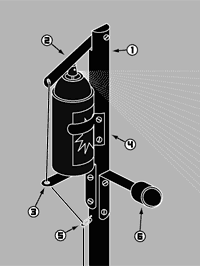Billboard Alteration
Apapted from Ecodefense
For a simple splatter effect, paint bombs can be made in a number of ways and are useful to reach inaccessible billboards.
Here's how:
• Empty glass bottles need to be thrown with some force but are easy
to come by.
• Eggs are also very effective: make two small holes in the shell
and blow the raw egg out like in primary school. Pour thinned-down paint
into a bottle with a thin nozzle (like a sauce bottle) and fill the egg.
Seal up the holes with candle wax and you have a mini paint bomb.
• Balloons are perfect paint bombs. Attach them to the end of a couple
of metres of hose or tubing. Thin your paint down and pour through the
hose (which will create the pressure required to expand the balloon).
Balloons are very sturdy and easily transported. You could even use a
slingshot to launch them.
• Some people claim to have used 'super-soaker' style water guns
with success. Make sure to rinse them well though, because your little
cousin probably won't appreciate a clogged nozzle.
Revising billboards is an even better way to subvert their original message.
Break down the power of the billboard ad by answering it, looking at the space available and the way in which the words and images lend themselves to addition, alteration and comment. Humour is extremely effective in exposing the advertiser's real intentions. Replacing one slogan with another doesn't remove advertising, it just changes it, so consider your intentions. Above all, avoid spelling mistakes!
PAINTING
If the offending billboard is high up, get a ladder or build a spray can
extension rod:
Obtain a broom handle or another lightweight wooden pole (see illustration, 1). At one end, cut out a wedge, half the width of the pole. Fit a flat metal bar to the remaining wood (2). About 25cm from this bar (or the height of your spray can), attach a support clamp on which the can will rest (3). Fit an angle bracket on each side of the pole, about 15cm from the end (4). The spray can should fit between these brackets. Tie a length of plastic coated wire to the flat metal bar (2), feed it through a hole in the support clamp (3) and screw eyes attached the length of the pole (5). This wire, when pulled, will press down the nozzle of the spray can. An optional extra is the roll-top of a deodorant bottle, fitted to the support clamp (6). This will help maintain an even distance between the spray can and billboard. You may have to experiment a bit to get the right measurements to fit your can of paint. You will find the extension rod clumsy to use at first, but with practice they become very effective.
PASTING
Pasting is cheap and effective: you can cover a large billboard in a few
minutes and get a lot more info across to your audience than with a spray
can.
To enlarge a graphic or text for pasting onto a billboard:
Put your graphic on a standard A4 bit of paper. On the reverse side of
the sheet draw lines dividing the page into sixteenths. Cut the paper
up into a jigsaw puzzle of your graphic. Enlarge each of these on a photocopier
to 395% (400% will cut bits of your image off). Now paste all your enlargements
back together. You might even want to colour in your image at this stage.
For lettering you can print one letter per page on a computer, and if you search hard enough for fonts (try www.fontaddict.com for starters) you might even be able to match the original ad.
Make paste with white flour and hot water. Rice flour is good for extra sticking power. You can carry paste in plastic bags - less conspicuous than buckets - and use brushes or paint rollers.
